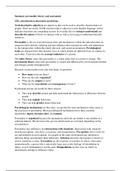Summary personality theory and assessment
CH1: introduction to personality psychology
Trait-descriptive adjectives are adjectives that can be used to describe characteristics of
people. There are nearly 20,000 trait-descriptive adjectives in the English language, which
indicates that there are compelling reasons in everyday life for trying to understand and
describe the nature of those we interact with as well as for trying to understand describe
ourselves.
Personality is the set of psychological traits and mechanisms within the individual that are
organised and relatively enduring and that influence their interactions with, and adaptations
to, the intrapsychic (within the mind), physical, and social environments. Psychological
traits are characteristics that describe ways in which people are different from (or similar to)
each other. Traits describe the average tendencies of a person.
The entity theory states that personality is a stable entity that is resistant to change. The
incremental theory states that personality is created and influenced by environmental stimuli
and changes greatly throughout life.
Research on personality traits asks four kinds of questions:
How many traits are there?
How are the traits organised?
What are the origins of traits?
What are the correlations and consequences of traits?
Psychological traits are useful for three reasons:
They help describe people and help understand the dimensions of difference between
people.
They help explain behaviour.
They can help predict future behaviour.
Psychological mechanisms are like traits, except that the term mechanisms refers more to
the processes of personality. Most psychological mechanisms have three essential
ingredients; inputs, decision rules, and outputs.
Personality is organised because the mechanisms and traits are linked to one another in a
coherent fashion. The decision rules govern which needs are activated, depending on the
circumstances.
Personality also influences our interactions with situations. Interactions with situations
include perceptions, selections, evocations, and manipulations. Perceptions refer to how we
see and interpret an environment; two people in the same environment pay attention to
different things and interpret them differently. Selection describes the manner in which we
choose situations to enter. Evocations are the reactions we produce in others, often quite
unintentionally; a person who is physically large may evoke feelings of intimidation in
others, even if intimidation is not the goal. Manipulations are the ways in which we
intentionally attempt to influence others.
,There are three levels of personality analysis:
Level of analysis Examples
Need to belong
Human nature (universal)
Capacity for love
Variation in need to belong (individual
difference)
Individual and group differences
Men more physically aggressive than
women (group difference)
Karel’s unique way of expressing his anger
Individual uniqueness Feline’s unique way of expressing her
curiosity
Personality psychologists debate whether individuals should be studied nomothetically or
idiographically. Nomothetic research involves individual instances of general characteristics
that are distributed in the population. Idiographic research involves single, unique cases.
Grand theories of personality describe universal traits. Many of those theories are primarily
of historical interest and only portions of them have stood the test of time and inform
personality research today. Most of the empirical research in contemporary personality
addresses the ways in which individuals and groups differ.
There are six domains of knowledge about human nature. A domain of knowledge is a
speciality area of science and scholarship, in which psychologists have focused on learning
about some specific and limited aspects of human nature. The six domains together describe
personality functioning as a whole. There are two key elements within each of the domains:
The theories that have been proposed within each domain, including the basic
assumptions about human nature.
The empirical research that has been accumulating within each of these domains.
The dispositional domain deals centrally with the ways in which individuals differ from one
another and, therefore, cuts across all the other domains. What distinguishes the dispositional
domain is an interest in the number and nature of fundamental dispositions. The goals of
psychologists in this domain are to identify and measure the most important ways in which
individuals differ from one another, finding the origin of the important individual
differences, and finding how the differences develop and are maintained.
The core assumption within the biological domain is that humans are collections of
biological systems, and these systems provide the building blocks for behaviour, thought, and
emotion. Biological approaches typically refer to three areas of research within this general
domain; genetics, psychophysiology, and evolution of personality.
The intrapsychic domain deals with mental mechanisms of personality, many of which
operate outside of conscious awareness. The predominant theory in this domain is Freud’s
psychoanalysis.
The cognitive-experiential domain focuses on cognition and subjective experience, such as
conscious thoughts, feelings, beliefs, and desires about oneself and others. This domain
involves the self, self-esteem, intelligence, personal goals, and emotions.
,The assumption of the social and cultural domain is that personality is not something that
merely resides within the heads, nervous systems, and genes of individuals. Rather,
personality affects, and is affected by, the social and cultural context.
The adjustment domain refers to the fact that personality plays a key role in how we cope
with, adapt, and adjust to the ebb and flow of events in everyday life.
A good theory fulfils three purposes in science:
It provides a guide for researchers.
It organises known findings.
It makes predictions.
There are five scientific standards for evaluating personality theories:
Comprehensiveness. Explains most or all known facts.
Heuristic value. Guides researchers to important new discoveries.
Testability. Makes precise predictions that can be empirically tested.
Parsimony. Contains few premises or assumptions.
Compatibility and integration across domains and levels. Consistent with what is
known in other domains; can be co-ordinated with other branches of scientific
knowledge.
CH2: personality assessment, measurement, and research design
There are different sources of personality data. Each of these sources of data reveals
something about the personality of an individual, yet each alone is incomplete and may be
biased.
Self-report data (S-data) is maybe the most obvious source of information about a person; it
is the information a person reveals themselves. Interviews and questionnaires can be used
as a self-report measure, and both can be either unstructured (open-ended questions) or
structured (closed-ended questions). However, S-data is always subject to response sets
(non-content responding), acquiescence (yeah saying), extreme responding, and social
desirability.
Observer-report data (O-data) is provided by friends, families, teachers, and acquaintances
of the individual or by professional personality assessors. Observations can be made in
naturalistic or artificial settings.
Another common source of personality-relevant information comes from standardised tests;
test data (T-data). In these measures, participants are placed in a standardised testing
situation. The situation is designed to elicit behaviours that serve as indicators of personality
variables. Mechanical recording devices can be used to measure personality differences as
well. The actigraph, for example, is essentially a modified self-winding watch (for children)
which measures activity levels (it is activated by movement). Physiological data, such as
measures of heart rate, can also be used to measure personality differences. The last type of
T-data are projective techniques, such as Rorschach’s Inkblot Test.
, Life-outcome data (L-data) refers to information that can be gleaned from the events,
activities, and outcomes in a person’s life that are available to public scrutiny, such as jobs,
marriages, and divorces. Personality psychologists often use S-data and O-data to predict L-
data.
Agreement among different data sources tend to range from low to moderate. By using
several sources, psychologists are able to average out the results from each source to create
an overview of personality traits that is as accurate as possible. Each data source also has its
own problems and pitfalls that limit its utility. However, if the same results are found with
two or more data sources, researchers can have greater confidence in the credibility of those
findings. Aggregation is the process of adding up, or averaging, several single observations,
resulting in a better (more reliable) measure of a personality trait than a single observation of
behaviour.
CH3: traits and trait taxonomies
A trait taxonomy is an organised scheme that includes all of the major traits of an
individual’s personality. A trait can be described as an internal causal property; a trait is an
internal need that causes behaviour. A trait can also be described as a descriptive summary;
a trait describes a recurring set of behaviours.
Personality and personality traits are quite consistent over the course of someone’s life.
However, the manifestation of personality traits shifts with age. This form of personality
development is called personality coherence. Within-person fluctuations of behaviour over a
short period of time are caused by states.
The act frequency approach is a research programme used by psychologists who endorse
the descriptive summary formulation of traits. This approach divides traits as categories of
acts. The first step of this approach is act nomination; a procedure designed to identify
which acts belong in which trait categories. The second step is prototypicality judgement;
identifying which acts are most central to each trait category. The final step is the recording
of act performance.
However they describe personality traits, all personality psychologists are involved with
identifying the most important traits. There are three fundamental approaches to identify
important traits. The lexical approach starts with the lexical hypothesis; all important
individual differences have become encoded within the natural language. The lexical
approach yields two clear criteria for identifying important traits; synonym frequency and
cross-cultural universality. Synonym frequency means that the more synonyms a trait
adjective has, the more important the dimension of individual difference is. Cross-cultural
universality refers to the number of languages that have a term for a certain trait; the more
languages have a term for it, the more important it is. Adjectives that describe physical
appearance, intellectual capabilities, temporary moods, and strong judgements are not
included in the lexical approach. The Five Factor Personality Inventory (FFPI) is a
questionnaire based on the Big Five and the lexical approach.
The most commonly used statistical approach to identifying important traits is factor
analysis. A factor analysis reveals which acts covary and can, therefore, create one trait
category. Factor loadings are indexes of how much of the variation in an act is explained by
the trait category. The higher these indexes are, the more the act fits in the trait category.





